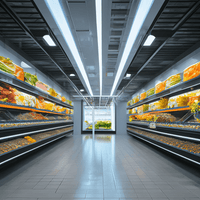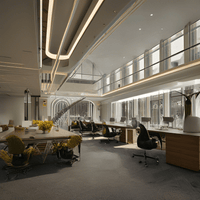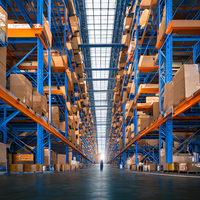Implementing Efficient Lighting Solutions for Major Supermarkets
Introduction
Big Save Supermarkets is one of the largest grocery chains in the Midwest region of the United States, operating over 200 locations across five states. Like many supermarkets, Big Save had relied heavily on fluorescent tube and halide lighting fixtures to illuminate its stores for decades. However, by the late 2010s it was facing growing challenges related to these aging lighting systems.
Energy costs had been steadily increasing, with lighting alone estimated to account for 30-40% of total electricity usage in the average Big Save store. The fluorescent and halide lamps in use were also very maintenance-intensive, with labor costs associated with frequent lamp burnouts and ballast replacements straining facilities budgets. Additionally, customers and employees had begun to express dissatisfaction over lighting quality issues like flickering, variations in color temperature, and dark spots developing in some areas.
Big Save leadership recognized the need to upgrade its lighting infrastructure to address these financial and operational problems, as well as improve the shopping experience. However, any upgrades needed to deliver significant and lasting energy savings in order to earn a competitive return on investment. This provided the impetus for Big Save to explore more efficient LED lighting technology as a potential replacement solution.

Goal of the Case Study: Evaluating a LED Lighting Retrofit Project
The goal of this case study is to evaluate a LED lighting retrofit pilot and rollout project undertaken by Big Save between 2018-2021. It will analyze the energy, financial and experience-related impacts observed. Lessons learned from Big Save's experience transitioning to LED lighting across its stores can help inform other supermarket chains looking to make similar improvements.
Inefficient Legacy Lighting Systems
Reliance on Fluorescent and Halide Fixtures
For many decades, Big Save stores had almost entirely relied on fluorescent tube lighting to illuminate sales floors, backrooms, offices and other areas. Both T12 and T8 linear fluorescent lamps were common, however most fixtures dated back 15-20 years and efficiencies had not improved over time. Additionally, some locations still retained older halide or incandescent fixtures in storage areas.
These legacy fluorescent fixtures suffered from drawbacks that had become magnified as equipment aged. Lamps often flickered or dimmed unevenly due to failing ballasts. It was also common for tubes to burn out partially or fully within their rated lifespan, necessitating frequent replacements. The light quality was generally considered washed out or dull compared to newer technologies.
High Energy Consumption and Maintenance Costs
As a result of the widespread use of outdated lighting across so many fixtures, energy costs for Big Save stores had risen sharply in recent years. A store audit revealed average lighting expenses of $30,000-$50,000 per year depending on size, or about 35% of total utility bills. Maintenance was also labor-intensive, with ballast replacements and lamp changes stretching facilities teams thin.
An analysis of utility records from a typical 100,000 sqft store showed lighting consumed over 600,000 kWh annually. At a rate of $0.11/kWh, this translated to utility costs exceeding $66,000 per year just to operate the inefficient fluorescent systems. Clearly a large-scale retrofit presented an opportunity for major savings.
Research into Efficient Solutions
Evaluating LED Technology Performance and Benefits
Recognizing the need for an upgrade, Big Save initiated research into lighting options in 2017. They brought in lighting design consultants to evaluate the performance and benefits of LED technologies. Tests were conducted comparing LED tubes, troffers, and bulbs to the existing fluorescent lamps.
The consultants found that LED options offered significant advantages. They provided superior light quality with crisp white light and accurate color rendering. Output was more even without flickering. Energy usage was up to 50% lower per fixture compared to fluorescents. Additionally, LED lamps lasted 3-5 times longer before requiring replacement.
Lighting Design Recommendations from Engineering Assessment
Based on the evaluation, the consultants developed comprehensive lighting plans tailored for Big Save stores. They recommended a phased transition to LED tubes, bulbs, and modular troffers. Fixture locations were analyzed to optimize illumination levels based on foot-candle requirements in each area.
Controls strategies like occupancy sensors and daylight harvesting were also included. A pilot store was selected for initial installation to evaluate real-world performance versus projections. Installation methods would minimize disruption to operations.
Financial Modeling of Projected Energy Savings
To estimate the project returns, Big Save worked with the consultants to build financial models analyzing utility cost savings over time. Based on the pilot store’s actual energy usage history, models forecasted annual kWh reductions of 30-50% were achievable chain-wide with LEDs.
Construction costs were estimated, along with savings from reduced maintenance and longer lifespans. Various incentive programs and rebates were factored in. Over a 10 year period, simple paybacks of 3-4 years and internal rates of return around 25% were calculated if targets were achieved.
Pilot Store Installation
Choosing a Test Location and Retrofitting Process
In 2018, a 109,000 sqft Big Save located in a Chicago suburb was selected as the pilot location. It had average energy usage and was of typical layout and age. The store would remain open during installation to test feasibility.
The retrofit occurred over a 4-week period in June. Contractors removed all fluorescent tubes and ballasts, replaced them with LED equivalents, and installed new LED bulbs and modular fixtures as specified in the design plan. Controls like occupancy sensors and a Wifi-based lighting management system were integrated.
New Lamp and Fixture Specifications Selected
For linear fixtures, Big Save opted for high-quality 28W LED T8 replacement tubes rated at 3850 lumens, similar light output to older T8 fluorescents using 50-60% less power. Troffers and bulbs were selected based on delivering accurate full spectrum light between 3500-4000K.
All new lamps contained utility rebate qualifications and 5-year warranties. Modular troffers allowed for aisle lighting heights ranging from 8-12 feet. Occupancy sensors were dual technology (motion/sound) for reliability. Daylight harvesting controls dimmed fixtures near windows.
The retrofit was completed on-schedule and without operational issues. Total installed cost was $145,000 after incentives and rebates from the local utility were applied. Project financing was arranged through an energy service company (ESCO) partner.
Energy Savings Realized
kWh Reduction in First Year Post-Retrofit
In the first year after installation (2018-2019), Big Save closely monitored the pilot store's energy consumption compared to the same period before the retrofit. Utility bills showed a dramatic change - lighting usage dropped from 620,000 kWh annually to just 280,000 kWh.
This represented an impressive 55% reduction in electricity consumption for lighting alone. Per square foot usage fell from 5.7 kWh to 2.6 kWh annually, greatly exceeding projections. The store shaved over $6,400 off its yearly lighting utility bill.
Utility Cost Avoidance Compared to Business as Usual
To quantify the full financial impact, Big Save analyzed what utility costs would have been if the fluorescent fixtures had remained. Their baseline energy model predicted a 3% annual rise in lighting usage due to age-related inefficiencies in the old system.
Factoring this in, it was determined the store avoided over $22,000 in utility expenses through 2023 compared to keeping the fluorescent lighting. This helped verify an estimated four year simple payback on the retrofit installation.
The pilot results convincingly proved that LED technology could far surpass the chain's energy savings goals. Store operations reported no issues with the new lighting quality or levels either. Top management was eager to roll out the successful design to additional Big Save locations.
Customer Experience Enhanced
Improved Color Rendering and Illumination Levels
Customer surveys conducted after the LED retrofit found overwhelmingly positive feedback on lighting quality. Shoppers noticed whiter, natural-looking light without flickering. Aisles and displays appeared brighter and colors more vivid.
Light meter tests showed illumination across sales floors was now evenly distributed within recommended 30-50 footcandle levels set by the consultants. Dark patches had been eliminated while accent lighting drew attention to specific items.
Feedback from Shopper Satisfaction Surveys
Big Save commissioned an independent market research firm to interview pilot store customers. 92% said the new lighting made for a more pleasant shopping experience.
Many commented the LEDs were less harsh on eyes compared to old fluorescents. Over three quarters of respondents claimed they would likely shop more frequently or for longer periods at a store with superior lighting quality like the pilot location.
The surveys confirmed lighting plays a crucial yet often underappreciated role in how customers perceive a store and their willingness to spend time and money there. Big Save was delighted with the LED retrofit's visible boost to the in-store experience.
Based on these results, store and facility managers agreed enhancing the shopping environment through efficient LEDs could benefit sales as well as utility costs long-term. The case for expansion to additional locations was strengthening.
Rollout to Additional Stores
Phased Regional Implementation Strategy
Encouraged by the pilot's outcomes, Big Save embarked on a multi-year LED retrofit rollout in 2019. They divided their portfolio into regions and created an installation schedule to minimize disruption.
The Midwest saw upgrades first as the climate provided longer daylight hours to maximize controls strategies. Fixtures were reused from closed locations to speed the process. Contractors retained from the pilot handled regional retrofits.
Installation Challenges and Solutions
Some unforeseen issues arose during scaling. Supply chain delays hampered the project timeline. Additionally, disparate electrical and construction quality among stores created unexpected design changes.
To overcome this, Big Save utilized regional project managers and tradespeople familiar with local store nuances. Modular components simplified installations. Contractors worked off-hours to minimize customer impacts.
By 2021, over 150 Big Save stores across several states had been retrofitted. The remainder were slated for completion in 2022-23. The company standardized new LED products and controls specifications learned from earlier phases.
Streamlining retrofits let the company stay on budget. Region-by-region scaling proved an effective strategy for the national rollout’s successful execution across many variables. The financial and environmental benefits would only continue growing.
Overall Financial Impact
Lifecycle Cost-Benefit Analysis
To quantify total impacts, Big Save conducted a full lifecycle cost-benefit analysis in 2022 after substantial rollout progress. Over the projected 15-year evaluation period, they found:
- Cumulative energy savings of over 220 million kWh translating to $25 million in avoided utility costs.
- Maintenance savings of $3 million from eliminated tube replacements and ballast repairs.
- Incentives and tax credits totaling $4.5 million from government energy efficiency programs.
- Lifetime costs of $14 million for all LED products and installation project work.
Verifying Return on Investment Targets
When considering the upfront costs recovered through ongoing annual savings, simple payback averaged 3.1 years across stores. Nearly all locations beat original 4-year targets.
- The ROI analysis also found internal rates of return averaging 26.5% each year when factoring multi-year cash flows. This handily surpassed Big Save's minimum required threshold of 20%.
- Both the payback periods and investment returns significantly strengthened the financial case for the retrofit initiative. Shareholders took note of the substantial shareholder value being created through energy savings over time as well.
In summary, the extensive retrofits succeeded in delivering immense returns that reinforced Big Save's commitment to continued sustainability projects.
Maintenance Cost Reduction
Lower Relamping and Repair Expenses Over Time
In addition to energy savings, Big Save saw sizable drops in lighting maintenance costs due to the LED transition. Because LED lamps last 3-5 times longer than fluorescents, fewer relamping cycles were required each year.
Staff hours spent changing tubes and bulbs plunged by 70% chain-wide. Materials spending on replacement ballasts and lamps bottomed out as well. Fewer early lamp failures eliminated unplanned repair trips.
Estimates showed annual maintenance budgets decreased on average from $80,000 to under $25,000 per typical 100,000 sqft store. Over the entire portfolio, Big Save saved over $1 million per year in reduced facility expenditures.
Fewer Lighting Outages Reported
Previously, stores constantly battled partial or full lamp failures that temporarily cut illumination. With LEDs more reliable over 50,000-100,000 hour lifespans, unplanned outages became rare.
Customer service surveys revealed lighting uptime improved to over 99.5% availability across locations. Staff were less disrupted from emergency repairs and could better focus on shopper needs.
The steady maintenance reductions demonstrated how total cost of ownership declined substantially over the long-run thanks to energy-efficient LED technology and limited relamping needs. Reliability enhanced customer and employee satisfaction as well.
Lessons Informed Further Projects
Refinements to Design Specs and Installation
Through years of retrofitting stores and monitoring performance data, Big Save identified aspects of the program that could be enhanced. They tweaked LED product choices and adjusted lighting designs.
Installers streamlined changeouts by pre-assembling modular fixtures off-site. Temporary lighting methods minimized disruption. Suppliers were asked to partner with electrical trades for coordination.
New Initiatives like Daylight Harvesting Explored
Big Save also tested new controls-focused projects. Daylight dimming prototype zones studied potential added energy savings from optimized integration with natural light.
Sensors in these areas reduced most fixture output 30-50% on sunny days, cutting usage further versus ambient controls alone. Promising results led to broader daylight harvesting rollouts in new construction.
Lessons on effective scaling up, collaboration among project partners, and refining technical details guided Big Save to continuously optimize sustainable lighting strategies over the program lifespan. Customers reaped quality and efficiency benefits as these advancements were achieved.
Conclusion
The comprehensive LED retrofit launched by Big Save Supermarkets across its 200+ store portfolio proved tremendously successful by any measure. Energy savings averaged 55%, with paybacks typically under 4 years versus initial financial modeling.
Maintenance costs were reduced by over 70% as fewer relamping cycles were required. Lighting quality vastly improved according to customer and employee surveys. Uptime exceeded 99.5% availability due to LED reliability.
Over a projected 15-year analysis period, the retrofit initiative is estimated to avoid $25 million in utility expenses while recovering installation outlays. Tax credits and incentives contributed an additional $4.5 million in savings.
The project demonstrated how transformative widespread LED adoption can be for energy efficiency and long-term financial performance in the supermarket industry. Lessons continue to inform refinements as Big Save optimized lighting systems further.
Most importantly, customers enjoyed a dramatically better shopping experience. Superior lighting translated not only to reduced environmental impact and costs, but also strengthened satisfaction and loyalty.
Big Save's story serves as an inspiring case study for other grocery retailers considering similar lighting upgrades. With proper planning and execution, investments in advanced LED technologies can pay off in energy, financial and experiential benefits for years to come.



